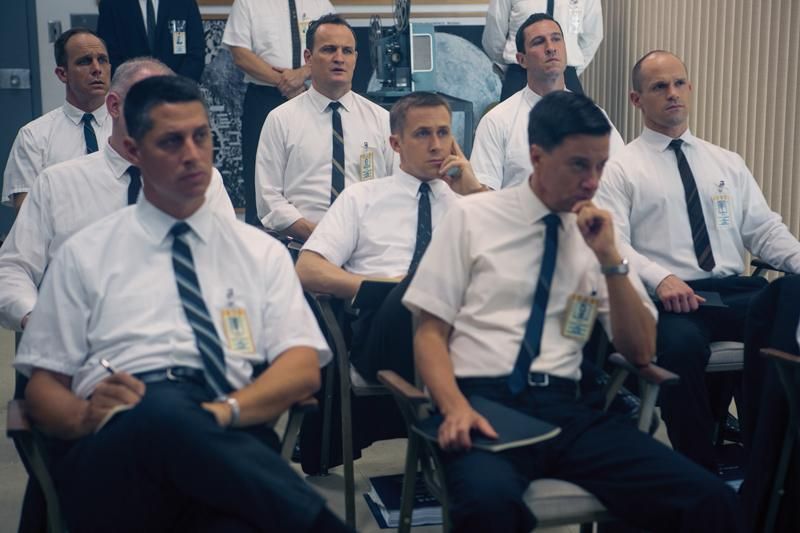Doing Right by Neil Armstrong
The makers of First Man took many great leaps to create an authentic portrait of the publicity-averse astronaut.
:focal(407x144:408x145)/https://tf-cmsv2-smithsonianmag-media.s3.amazonaws.com/filer/56/91/5691a103-eae0-4cf1-b699-7f192d8fb867/gosling_spacesuit.jpg)
First Man, writer-director Damien Chazelle’s new historical drama about Neil and Janet Armstrong in the decade that culminated with Armstrong’s walk on the Moon, is a surprisingly intimate portrait of a deeply modest and private man, and a marriage strained by grief. Josh Singer adapted the screenplay from James R. Hansen’s mammoth 2005 biography First Man: The Life of Neil A. Armstong—the only Armstrong book in which the astronaut took part, sitting for some 50 hours of interviews with the author. The 1962 death of the Armstrongs’ two-year-old daughter Karen was one of the little-known elements of their lives that Neil discussed with Hansen in his book, and it is this tragic event that becomes the emotional foundation of the new movie.
Though Neil and Janet have since died, Hansen remained involved in the production to ensure the film version of First Man would be something its publicity-averse subjects would have approved. At the film’s North American premiere at the National Air and Space Museum last week—an event attended by stars Ryan Gosling and Claire Foy (who play Neil and Janet Armstrong) and Chazelle (who worked with Gosling on La La Land), and many other key members of the film’s cast and crew as well as Apollo 11 astronaut Mike Collins and Armstrong's sons Mark and Rick—Hansen and Singer discussed their collaboration.
/https://tf-cmsv2-smithsonianmag-media.s3.amazonaws.com/filer/ac/c6/acc6cba2-c63c-482b-894d-6a3bb73927ba/2493_d018_00234rv3_grdjpg_cmyk.jpg)
“Jim had uncovered all sorts of things that I think aren’t widely known,” Singer said. “The fact that Neil had a daughter, the fact that he was so close to Elliot See and Ed White [who perished in separate accidents in 1966 and 1967]. There are things that I think the wider public has no knowledge of.” The screenwriter said people his age and younger—he was born in 1972—don’t generally know about Armstrong’s role in the X-15 program, or his cool-headed resolution of an emergency that arose during Gemini 8. But even though Singer, who also wrote the screenplay for the 2015 journalism drama Spotlight, felt confident much of Armstrong’s story would be unknown to First Man’s audience, he knew that building a story around such a modest giant would be difficult.
“He’s a private guy, Singer said. "He’s emotionally tightly-packaged. We had to spend a lot of time with Rick and Mark Armstrong, with Janet and with June Hoffman, his sister, to try to get at who this guy really was.” NASA also put him in touch with Collins, Jim Lovell, and others who worked closely with Armstrong.
“The real trouble was the responsibility you feel to get it right,” Singer said. “Showing something as obvious as Neil crying after the death of his daughter is going to be provocative to a lot of people. So if you’re going to show that, you’d better get everything right, so they don’t think you’re just making it up.”
Hansen said Singer was quite receptive to help from a man who had shouldered that responsibility already. “Josh had me review his preliminary outline and then every version of the script," Hansen said. “So I had my chance to critique it, and I did, believe me.”
Hansen cited a scene in the film where Chief Astronaut Deke Slayton telephones Armstrong at a White House event to notify him of the launchpad deaths of Virgil “Gus” Grissom, Ed White, and Roger Chaffee as one where he intervened to prevent the filmmakers’ dramatic license from straying off course. As initially scripted, Armstrong slams down the telephone and breaks it at the conclusion of the call. Hansen told Singer that Armstrong would never permit himself such an eruption, no matter how sad or angry he was. Hansen said that Singer’s proposed replacement, where Armstrong inadvertently crushes a wine glass he’s holding in his fist, while an invention, was one that rang true to Armstrong’s taciturn nature. And that’s the one in the movie.

While compressing the events of eight years into roughly 140 minutes of screen time necessitates some judicious fudging, Chazelle was determined to make his adaptation of the book as documentary-like as possible. This meant shooting the bulk of the film using 16mm and 35mm photochemical stock—increasingly seen as a novelty in an era when moviemaking has long since gone digital—and even taking a unique approach to the movie’s visual effects. For most movies and television shows, visual effects shots are created separately, far away from where the actors are performing for the cameras, and then composited together during post-production.
Paul Lambert, First Man’s visual effects supervisor, said his team built a 35-by-60-foot LED video wall to display high-resolution cockpit views—created via computer graphics—for Gosling on the set, allowing him to react to something he was really seeing. “We provided content for the entire X-15 sequence,” set in 1961, that opens the film, Lambert said. “When Ryan’s in the cockpit and he’s breaking through the atmosphere, and the horizon comes up in the reflection of his helmet, that’s all in-camera,” Lambert said, using term of art for an effect that is captured in the original shot rather than added later. “So he’s reacting to that horizon appearing. You can see the reflection in his eyeball.” This approach freed the filmmakers from the more rigid approach of having to construct a sequence around a set number of individual effects shots, and spared Gosling the chore of having to feign a reaction to something that will be added later, as is typically the case in effects-heavy movies.
The result of all this expert stagecraft is create a visceral simulation of the risk and exhilaration of leaving Earth’s atmosphere, and an intimate portrait of a deeply private pioneer.
First Man opens in theatres nationwide today.